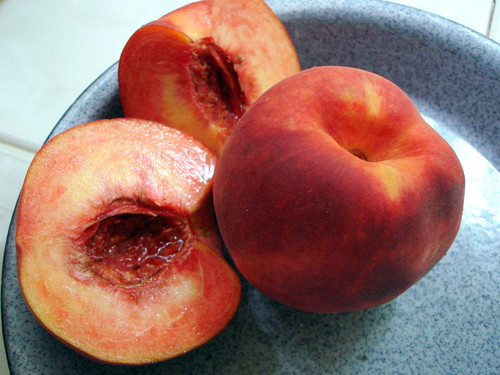
Have you ever had the unpleasant experience of biting into a delicious-looking peach, such as these, and ending up with a mouth full of tasteless mush? Well, I have, and it has happened one too many times for me. My latest experience comes from South Carolina peaches that I purchased yesterday at a boutique or upscale grocer in my neighborhood. In the past I've had good experiences purchasing fresh fruit there, but now it seems they have begun marketing mushy fruit too.
Three years ago when I first blogged about my disgust at purchasing mushy peaches, I asked America's grocers and fruit growers why they hoodwink American consumers into purchasing their picture-perfect fruit, such as these peaches, when the fruit is unfit for human consumption.
Mushy Peaches , 2 September 2006 - 3 Photos
I photographed the peaches to show their beautiful appearance before I flushed them down the garbage disposal. These peach beauties were home-grown. They spent months in orchard sunshine, precious Arab fuel was expended to take them to market, a customer spent hard-earned dollars to purchase them from a grocery store, and then they were sent down the drain, as they were too mushy and tasteless for human consumption.
At that time I received an email from a peach grower who told me I was being unfair to blame mealy peaches on the fruit growers, as he explained that the peaches are perfect when shipped from the orchards, but are damaged by being transported or stored at cold temperatures. He wrote that growers refer to this mealiness condition as “internal breakdown” and that it is the result of improper handling after the fruit leaves the orchard’s facility.
When fruit leaves the grower’s cold storage it travels in refrigerated vans, is unloaded to a retailers’ warehouses, sent to stores’ back rooms, placed upon store shelves, before being purchased by consumers. At any one of these points, if the fruit is subjected for too long to temperatures in the range of 36-46F, which growers dub the Killing Zone, there will be internal breakdown. Because the grower has no control over the fruit once it leaves his facility, he questioned whether growers deserve my bad publicity for as he claimed, “We do not ship mealy fruit.” Well, it was not my fault, as I never place fresh peaches in the refrigerator.
What infuriates me so much, is that when I as a consumer purchase pears and peaches, I cannot tell by their appearance that they have already been ruined for human consumption. The grocer obviously knows that they have, for he or she can taste-test samples. Yet grocers sell them anyway.


